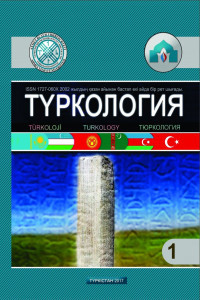NAHÇİVAN DİYALEKTİNİN AZERBAYCAN TÜRKÇESİ DİYALEKTLERİ İÇİNDEKİ YERİ
Kelime, Kelime grubu, Söz varlığı, Edebî dil, NAHÇİVAN diyalekti
POSITION OF THE NAKHCHIVAN DIALECT IN THE DIALECT SYSTEM OF AZERBAIJAN LANGUAGE
Dialects and Accents of Nakhchivan Autonomous Republic, Lexicon, Literary Language, Terminological Vocabulary, Words Without Term Character,
___
- 1. Чобанзаде Б.В. Избранные произведения. Баку: Восток-Запад, 2007. - 336 с.
- 2. Ширалиев М.Ш. Основы Азербайджанской диалектологии. Баку: Восток-Запад, 2008. - 416 с.
- 3. Диалекты и говоры Нахчыванской группы Азербайджанского языка. Баку: Азерб. Издательство АН ССР, 1962. - 326 с.
- 4. Джафаров С.А. Современный Азербайджанский язык. Лексика. Баку: Восток-Запад, 2007. - 191 с.
- 5. Рзаев Ф.Г. Из истории этногенеза населения Нахчывана. Баку: АГУП, 2013. -528 с.
- 6. Словарь тюркских наречий. Анкара: Башбаканлык Басымеви, 1992. - 1183 стр.
- 7. Курбанов А.М. Современный Азербайджанский литературный язык. Баку: Просвещение, 1985. - 408 с.
- 8. Исакова А.А. Русские заимствования в словаре диалектов Сибирских татар Д.Г.Тумашевой. Вестник Томского Государственного Университета, 2016, № 413. - C. 34-37.
- 9. Мусаев К. Лексикология тюркских языков. М.: Наука, 1984. - 226 с.
- 10. Севортян Э.В. Этимологический словарь тюркских языков (общетюркские и межтюркские основы на гласные). М.: Наука, 1974. – 767 с.
- 11. Древнетюркский словарь. Л.: Наука, 1969. – 676 с.
- ISSN: 1727-060X
- Başlangıç: 2002
- Yayıncı: Hoca Ahmet Yesevi Uluslararası Türk-Kazak Üniversitesi
KIPÇAK TÜRKÇESİ SÖZ VARLIĞINDA SİNONİM KELİMELER
KAZAK EDEBİYATI TARİHİ VE ARAŞTIRILMASI
Ye. ALASHBAYEV, Sh. USENBAYEVA, Ye. DZHASYMBEKOV
NAHÇİVAN DİYALEKTİNİN AZERBAYCAN TÜRKÇESİ DİYALEKTLERİ İÇİNDEKİ YERİ
BAŞKURT TÜRKÇESİNİN DİYALEKTOLOJİK SES LABORATUARI İÇİN GEREKLİ MALZEMELERİN ARAŞTIRILMASI
Z.a. SYRAZITDINOV, L.a. BUSKUNBAEVA, A.sh. ISHMUKHAMETOV
TÜRK UYGARLIĞINA GİRİŞ: MEVCUT VE YENİ PARADİGMALAR
SANAT USTASI KALMİRZA TASOV'UN YARATICILIĞI
ANTALYA YÖRESİ AĞIZLARINDA ESKİ TÜRKÇE ÖTÜMSÜZLÜKLERİN KORUNUMU VE DAĞILIMI
AZERBAYCAN’IN KUZEYBATI BÖLGESİ HALKININ GELENEKSEL HALK OYUNLARINDA KADİM TÜRK FOLKLORUNUN İZLERİ
